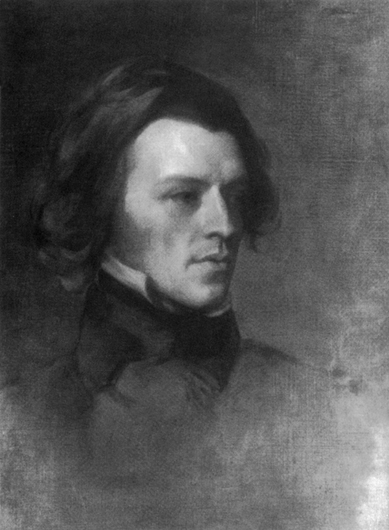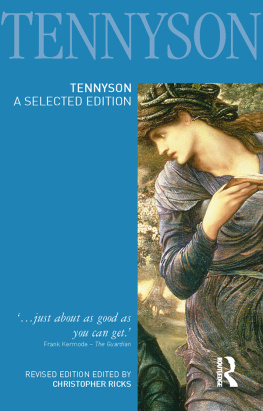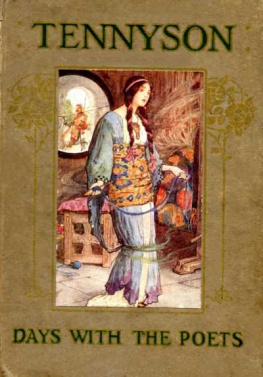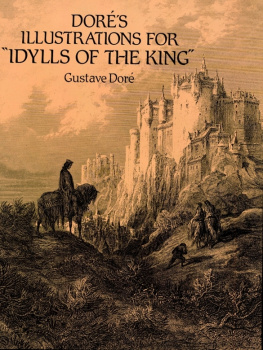Tennyson A Selected Edition LONGMAN ANNOTATED ENGLISH POETS General Editors: John Barnard and Paul Hammond
Founding Editor: F. W. Bateson Titles available in paperback: BLAKE: THE COMPLETE POEMS
(Third Edition)
Edited by W. H. Stevenson DRYDEN: SELECTED POEMS
Edited by Paul Hammond and David Hopkins THE POEMS OF ANDREW MARVELL
(Revised Edition)
Edited by Nigel Smith MILTON: PARADISE LOST
(Second Edition)
Edited by Alastair Fowler MILTON: COMPLETE SHORTER POEMS
(Second Edition)
Edited by John Carey SPENSER: THE FAERIE QUEENE
(Revised Second Edition)
Edited by A. C.

Tennyson aged about 31. By Samuel Laurence. (By kind permission of the National Portrait Gallery.) TENNYSON A Selected Edition Edited by CHRISTOPHER RICKS
Revised Edition
First published 1969 by Pearson Education Limited
First paperback edition 1989
Revised edition published in Great Britain in 2007 Published 2014 by Routledge
2 Park Square, Milton Park, Abingdon, Oxon OX14 4RN
711 Third Avenue, New York, NY 10017, USA
Routledge is an imprint of the Taylor & Francis Group, an informa business Copyright 1969, 1989, 2007, Taylor & Francis. All rights reserved. No part of this book may be reprinted or reproduced or utilised in any form or by any electronic, mechanical, or other means, now known or hereafter invented, including photocopying and recording, or in any information storage or retrieval system, without permission in writing from the publishers. Notices
Knowledge and best practice in this field are constantly changing.
As new research and experience broaden our understanding, changes in research methods, professional practices, or medical treatment may become necessary. Practitioners and researchers must always rely on their own experience and knowledge in evaluating and using any information, methods, compounds, or experiments described herein. In using such information or methods they should be mindful of their own safety and the safety of others, including parties for whom they have a professional responsibility. To the fullest extent of the law, neither the Publisher nor the authors, contributors, or editors, assume any liability for any injury and/or damage to persons or property as a matter of products liability, negligence or otherwise, or from any use or operation of any methods, products, instructions, or ideas contained in the material herein. ISBN 13: 978-1-4058-3282-3 (pbk) British Library Cataloguing in Publication Data
A CIP catalogue record for this book can be obtained from the British Library Library of Congress Cataloging in Publication Data
A CIP catalog record for this book can be obtained from the Library of Congress Set by 35
Contents
The Round Table:Longman Annotated English Poets was launched in 1965 with the publication of Kenneth Allotts edition of
The Poems of Matthew Arnold. F.W. Bateson wrote that the new series is the first designed to provide university students and teachers, and the general reader with complete and fully annotated editions of the major English poets.
That remains the aim of the series, and Batesons original vision of its policy remains essentially the same. Its concern is primarily with the meaning of the extant texts in their various contexts. The two other main principles of the series were that the text should be modernized and the poems printed as far as possible in the order in which they were composed. These broad principles still govern the series. Its primary purpose is to provide an annotated text giving the reader any necessary contextual information. However, flexibility in the detailed application has proved necessary in the light of experience and the needs of a particular case (and each poet is by definition, a particular case).
First, proper glossing of a poets vocabulary has proved essential and not something which can be taken for granted. Second, modernization has presented difficulties, which have been resolved pragmatically, trying to reach a balance between sensitivity to the text in question and attention to the needs of a modern reader. Thus, to modernize Brownings text has a double redundancy: Victorian conventions are very close to modern conventions, and Browning had firm ideas on punctuation. Equally, to impose modern pointing on the ambiguities of Marvell would create a misleading clarity. Third, in the very early days of the series Bateson hoped that editors would be able in many cases to annotate a textus receptus. That has not always been possible, and where no accepted text exists or where the text is controversial, editors have been obliged to go back to the originals and create their own text. The series has taken, and will continue to take, the opportunity not only of providing thorough annotations not available elsewhere, but also of making important scholarly textual contributions where necessary.
A case in point is the edition of The Poems of Tennyson by Christopher Ricks, the Second Edition of which (1987) takes into account a full collation of the Trinity College Manuscripts, not previously available for an edition of this kind. Yet the series primary purpose remains annotation. The requirements of a particular author take precedence over principle. It would make little sense to print Herberts Temple in the order of composition even if it could be established. Where Ricks rightly decided that Tennysons reader needs to be given the circumstances of composition, the attitude to Tennyson and his circle, allusions, and important variants, a necessary consequence was the exclusion of twentieth-century critical responses. Milton, however, is a very different case.
John Carey and Alastair Fowler, looking to the needs of their readers, undertook synopses of the main lines of the critical debate over Miltons poetry. Finally, chronological ordering by date of composition will almost always have a greater or lesser degree of speculation or arbitrariness. The evidence is usually partial, and is confused further by the fact that poets do not always write one poem at a time and frequently revise at a later period than that of composition. John Barnard
Paul Hammond
This selected edition is excerpted from
The Poems of Tennyson, second edition, three volumes (1987). Each poem here is reproduced in full, together with the entire annotation (headnotes, footnotes, and alternative drafts) of the complete edition. For every poem included, then, this edition is identical with that of 1987.
Likewise for the Preface, below, and for the Acknowledgments; the Chronological Table of Tennysons Life and Chief Publications; and the Abbreviations. Tennysons four long poems are here: The Princess, In Memoriam, Maud, and Idylls of the King. So are all the masterpieces: onwards from Mariana, The Lady of Shalott, St Simeon Stylites, Ulysses, Tithonus The necessity of reducing, by more than half, the two thousand pages of the complete edition entailed the enforcing of one principle: the inclusion of no poem which Tennyson himself had not included in his final edition, whether left unpublished or published by him and later rescinded. But this did not retrench quite enough. Judgement has been exercised to represent all of Tennysons genius, in his many kinds of poetry and throughout the phases of his publishing career of over sixty years. The numbering of the poems in the complete edition has been retained, partly to facilitate the use of the two editions in conjunction, and partly because the footnotes were keyed to their poems through numbers; to change numbers would have been costly and might have introduced error as well as making for confusion in there being two distinct numberings. II 321. II 321.











 Tennyson aged about 31. By Samuel Laurence. (By kind permission of the National Portrait Gallery.) TENNYSON A Selected Edition Edited by CHRISTOPHER RICKS
Tennyson aged about 31. By Samuel Laurence. (By kind permission of the National Portrait Gallery.) TENNYSON A Selected Edition Edited by CHRISTOPHER RICKS